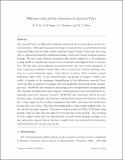| dc.contributor.author | Fu, Roger Rennan | |
| dc.contributor.author | Hager, Bradford H | |
| dc.contributor.author | Ermakov, Anton | |
| dc.contributor.author | Zuber, Maria | |
| dc.date.accessioned | 2017-01-24T16:04:07Z | |
| dc.date.available | 2017-01-24T16:04:07Z | |
| dc.date.issued | 2014-02 | |
| dc.identifier.issn | 0019-1035 | |
| dc.identifier.issn | 1090-2643 | |
| dc.identifier.uri | http://hdl.handle.net/1721.1/106596 | |
| dc.description.abstract | The asteroid Vesta is a differentiated planetesimal from the accretion phase of Solar System formation. Although its present-day shape is dominated by a non-hydrostatic fossil equatorial bulge and two large, mostly unrelaxed impact basins, Vesta may have been able to approach hydrostatic equilibrium during a brief early period of intense interior heating. We use a finite element viscoplastic flow model coupled to a 1D conductive cooling model to calculate the expected rate of relaxation throughout Vesta’s early history. We find that, given sufficient non-hydrostaticity, the early elastic lithosphere of Vesta experienced extensive brittle failure due to self-gravity, thereby allowing relaxation to a more hydrostatic figure. Soon after its accretion, Vesta reached a closely hydrostatic figure with <2 km non-hydrostatic topography at degree-2, which, once scaled, is similar to the maximum disequilibrium of the hydrostatic asteroid Ceres. Vesta was able to support the modern observed amplitude of non-hydrostatic topography only >40–200 My after formation, depending on the assumed depth of megaregolith. The Veneneia and Rheasilvia giant impacts, which generated most non-hydrostatic topography, must have therefore occurred >40–200 My after formation. Based on crater retention ages, topography, and relation to known impact generated features, we identify a large region in the northern hemisphere that likely represents relic hydrostatic terrain from early Vesta. The long-wavelength figure of this terrain suggests that, before the two late giant impacts, Vesta had a rotation period of 5.02 h (6.3% faster than present) while its spin axis was offset by 3.0 ° from that of the present. The evolution of Vesta’s figure shows that the hydrostaticity of small bodies depends strongly on its age and specific impact history and that a single body may embody both hydrostatic and non-hydrostatic terrains and epochs. | en_US |
| dc.description.sponsorship | National Science Foundation (U.S.). Graduate Research Fellowship Program | en_US |
| dc.language.iso | en_US | |
| dc.publisher | Elsevier | en_US |
| dc.relation.isversionof | http://dx.doi.org/10.1016/j.icarus.2014.01.023 | en_US |
| dc.rights | Creative Commons Attribution-NonCommercial-NoDerivs License | en_US |
| dc.rights.uri | http://creativecommons.org/licenses/by-nc-nd/4.0/ | en_US |
| dc.source | Prof. Hager | en_US |
| dc.title | Efficient early global relaxation of asteroid Vesta | en_US |
| dc.type | Article | en_US |
| dc.identifier.citation | Fu, Roger R. et al. “Efficient Early Global Relaxation of Asteroid Vesta.” Icarus 240 (2014): 133–145. | en_US |
| dc.contributor.department | Massachusetts Institute of Technology. Department of Earth, Atmospheric, and Planetary Sciences | en_US |
| dc.contributor.approver | Hager, Bradford H. | en_US |
| dc.contributor.mitauthor | Fu, Roger Rennan | |
| dc.contributor.mitauthor | Hager, Bradford H | |
| dc.contributor.mitauthor | Ermakov, Anton | |
| dc.contributor.mitauthor | Zuber, Maria | |
| dc.relation.journal | Icarus | en_US |
| dc.eprint.version | Author's final manuscript | en_US |
| dc.type.uri | http://purl.org/eprint/type/JournalArticle | en_US |
| eprint.status | http://purl.org/eprint/status/PeerReviewed | en_US |
| dspace.orderedauthors | Fu, Roger R.; Hager, Bradford H.; Ermakov, Anton I.; Zuber, Maria T. | en_US |
| dspace.embargo.terms | N | en_US |
| dc.identifier.orcid | https://orcid.org/0000-0003-3635-2676 | |
| dc.identifier.orcid | https://orcid.org/0000-0003-2652-8017 | |
| mit.license | PUBLISHER_CC | en_US |
